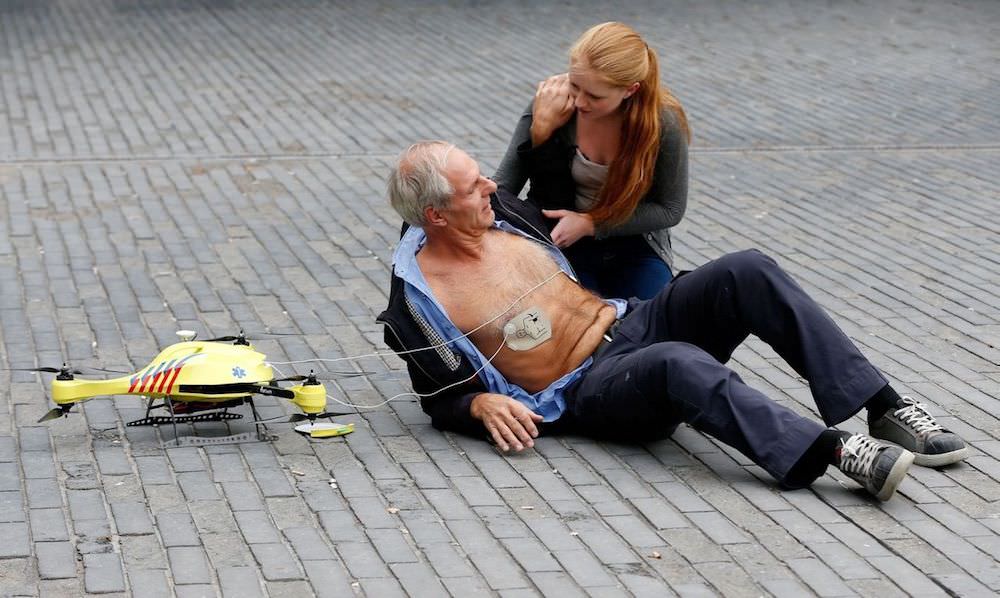
As part of the world’s reaction to the sudden and unexpected COVID-19 pandemic, vastly increased use of uncrewed aerial vehicles (UAV) to deliver critical medical supplies evolved from experimental to habitual phases in no time. That soon may also be the case with drones flying defibrillators to heart attack victims with improved, life-saving speed.
Responding to cardiac arrest emergencies from the skies
A trial using drones to fly automated external defibrillators (AED) to heart attack victims in Sweden suggests the method could end up saving more lives – and improving those spared – than relying only on the usual ground ambulances. The experiments using both methods in reaction to cardiac arrest emergencies showed UAV arriving considerably faster than road-based responders.
“Drones delivered an automated external defibrillator just outside the door of residential homes, where most cardiac arrests occur,” said Dr. Sofia Schierbeck, a researcher at Karolinska University Hospital in Stockholm in a report on the trials. “When a drone arrived before the ambulance it was nearly two minutes quicker. As drone technology improves it should be possible to increase the number of patients and the time benefits.”
Two minutes may not sound like the kind of speed and efficiency improvement to get too excited about. But when it comes the heart attacks, the added speed of drones delivering defibrillators to heart attack victims can be the difference between life and death. Those 120 seconds can also determine the quality of life of cardiac patients who survive.
Though CPR and heart massages are manual alternatives, use of AED is far more efficient in responding to those emergencies. The electric shocks they deliver to the heart usually get it working on its own much faster and more efficiently, reducing the various kinds of physical damage the body can suffer during arrest. Those crises still account for about 20% of all deaths in developed nations, where despite continuing medical advances to treat cardiac seizure, mortality rates are still about 90%.
The best chance of lowering those statistics is to get defibrillators to heart attack victims quickly – which is where drones come in.
“We believe that novel ways to provide AEDs are needed to increase the chance of survival in these patients,” Schierbeck noted. “Therefore, we performed the first-ever study to investigate the feasibility of drone delivery of AEDs to patients with suspected cardiac arrest outside of hospital.”
Drones proved effective in getting defibrillators to heart attack victims faster
The trials were carried out from June to September 2020 in the city of Gothenburg within a five kilometer radius of the local airport. Three drone teams were positioned in different zones, and prepared to respond alongside separate ambulance crews when cardiac arrest calls came in. Once the closest UAV was given air control authorization to fly, the drone was dispatched in automated mode to the address of the crisis, where it hovered at 100 feet and lowered the defibrillator to people helping the heart attack victim below.
Several previous experiments using the same approach were conducted in Sweden, with all showing promise of UAV effectiveness – and some reporting a whopping 16 minutes improvement in arrival time over ground services. But the Karolinska University Hospital was the first in which the craft were actually participating in real emergency response, rather than racing ambulances to see which arrived first.
“Unlike previous simulation studies, this was the first study to deploy drones with AEDs in real-life emergencies,” Schierbeck explained.
Drones were given clearance or were otherwise able to participate in reaction to 12 out of 53 cases of cardiac arrests called in. They successfully delivered AEDs to 11 of victims involved (a 92% rate). They beat ground services to emergency sites seven of those times, arriving with a median lead of 1:52 minutes, and flying median distances of 3.1 kilometers.
“Our study shows that it is not only possible but can be quicker than an ambulance,” Schierbeck said.
Some improvements must still be made, however. Weather conditions like rain, heavy wind, or Sweden’s brutal winter temperatures would make flying drones difficult, if not impossible in emergency response. Schierbeck says her team is looking for ways to work around those limitations for future tests next year.
FTC: We use income earning auto affiliate links. More.



Comments